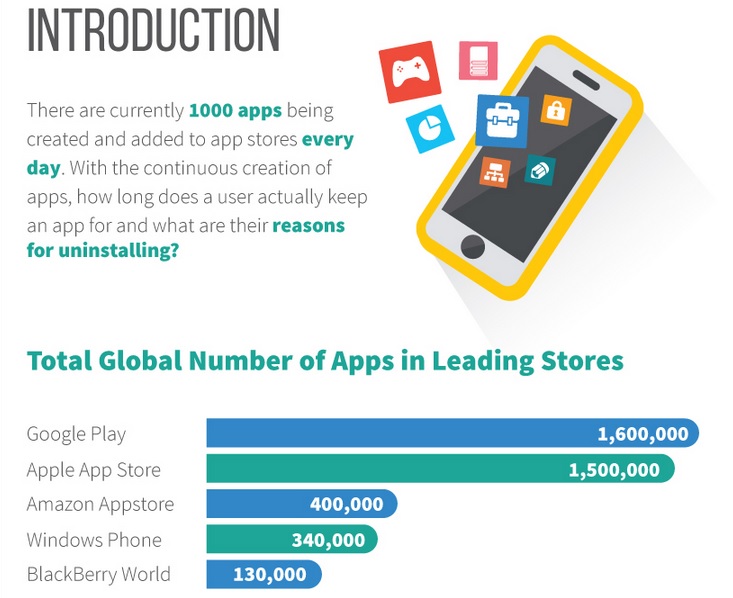Have You Ever Wondered Why People Uninstall Your Apps?

Although mobile apps are a relatively new member benefit for associations, most organizations realize apps are another valuable channel for sharing anything from event content to association news.
When your association creates an app as a member resource, whether it is for informational purposes or for connecting at an event, do you wonder why some users uninstall your app shortly after downloading it? Do you ask members why? If not, you’re missing a great opportunity to hear firsthand where your mobile app could be improved – as well as elements of it they liked. Asking members why they uninstalled your app will make it more user-friendly and engaging in the long run.
![]()
Mobile apps are a valuable channel for members to share anything from event content to association news.![]()
Business apps tend to have higher retention rates than non-business apps.![]()
People uninstall apps if they take up too much storage, have intrusive advertising, are poorly designed, or are hard to use.![]()
Improving your app retention rate
After initially downloading an app, we tend to dive right into its features and decide whether or not it’s worth the storage space on our mobile devices or tablets. According to an infographic created by International Translation Resources (ITR), the overall average app retention rate from month one to month two decreases from 36 percent to 29 percent. But, the average retention rate for business apps is higher than for non-business apps – 52 percent for the first 60 days, decreasing to 41 percent after 90 days.

Think about mobile apps as another form of your newsletter or magazine. You provide engaging content to encourage members to share and use that information, which makes them less likely to opt out. Transfer this same idea to your association’s mobile app strategy.
When your association decides to develop an app to keep members up-to-date or to stay connected at an event, it’s important to think about how you will keep them satisfied beyond the initial app install. If you’re dedicated to the success of your app, then you’ll be able to prevent a high number of uninstalls. But, keep in mind, uninstalls aren’t always a bad thing, nor do they indicate there’s an issue with your app. If your app doesn’t provide members with what they desire most, it will likely be uninstalled immediately. People cycle through apps quickly in order to find the ones that best fit their needs.
Why we uninstall apps
Some apps tend to have a limited lifecycle, such as event apps, because the event occurs at a particular time of the year. If your association’s annual conference has just ended, some attendees will inevitably uninstall your app. Others will collect event information, such as notes and connections, and then uninstall your app. But, they’ll remember how valuable your event app was and will likely install it again for the following year’s conference. Don’t forget to send them reminders as your event date draws closer.
People typically uninstall apps because they take up too much storage on their devices, or because they have intrusive advertising, use poor design, keep freezing, or are difficult to use. When designing your association’s app, put yourself in your members’ shoes. How can you make navigating the app as easy as possible? What items can you cut back on or eliminate entirely? Is the app free from bugs and glitches? Repeatedly test your app amongst staff and act on their feedback.
Making your app user-friendly
From your experience downloading and using apps, how often do you uninstall them because they aren’t easy to navigate? People are open to trying a new app, but they won’t keep using it if they find it too difficult to use or if they can’t easily find what they’re looking for.
From the survey conducted by ITR, there are several common app usability design mistakes:
- Non-standard GUI (graphical user interface) controls: These controls contain non-standard scrollbars, text and headlines that look like clickable links, and buttons that do not indicate an action.
- Inconsistency: Using different words or commands or using the same word for multiple concepts across the app can deter users from using your app efficiently.
- No default values: By not using drop-down menus in your app, you can slow down user interaction. Missing default values can cause confusion for what type of answer is appropriate for the questions you are asking.
- User dump: When you do not provide users with easy-to-understand set-up information after installing the app, they may remove the app. Also, if you do not make the set-up instructions simple and easy to read, users will quickly close the app.
- One-size-fits-all: If you design your app for one screen size, this will limit the number of devices your app will be able to work on. Don’t forget to take screen rotation into account either.
- Small-click targets: If you include small clickable items throughout your app, users might miss and select outside of the desired area. This may cause users to believe the clickable item isn’t actionable.
- Features overload: Just like push notifications, don’t overwhelm your users with too many features. This can give the perception of a complex or confusing app.
Conclusion
When your association decides to produce a mobile app, good user experience should be the core focus. Don’t forget to take the following into account:
- Look beyond the initial download step and focus on what makes your app worthy of keeping for the long haul.
- Remember to study the analytics of your app, such as the number of installs, in-app actions, and average number of actions per user. You can reveal information through your app provider’s dashboard about your members to aid in future updates of your association’s app.
- Make your app user-friendly just as you would with your association’s website.
What successes has your association seen with mobile apps? Tell us about it in the comments below.
Brianna Lawson is an online marketing specialist at Naylor Association Solutions.

